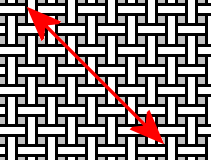Bias (textile) facts for kids
The bias of a piece of fabric is a special way it's cut. Imagine a woven fabric, like a shirt or a pair of jeans. It has threads going up and down (called the warp) and threads going side to side (called the weft). The bias is when you cut the fabric at a 45-degree angle to these threads. Every woven fabric has two biases, which are at right angles to each other. Fabrics that aren't woven, like felt, don't have a bias.
Why the Bias Cut is Special
When fabric is cut on the bias, it becomes much more stretchy and flows more easily. Think about how a stretchy T-shirt moves compared to a stiff canvas bag. This extra stretch and movement are super helpful for making clothes. It helps skirts, dresses, and even neckties hang nicely and move with your body.
How Tailors Use the Bias Cut
Tailors and dressmakers use a technique called the "bias-cut." Because fabric stretches more when cut diagonally, it helps clothes fit better and look more elegant. This cut helps clothes gently follow the body's shape and curves. For example, a full-skirted dress cut on the bias will hang more gracefully. A narrow dress will also cling nicely to the body.
History of the Bias Cut
The bias-cut became very popular in the 1920s. A famous fashion designer named Madeleine Vionnet used it a lot in her fancy "haute couture" clothes. Today, this cutting method is still used often in both high-end fashion and everyday clothing. Long ago, in the Middle Ages, before people started knitting much, leggings (called hose) were cut on the bias. This helped them fit much better on the legs.


